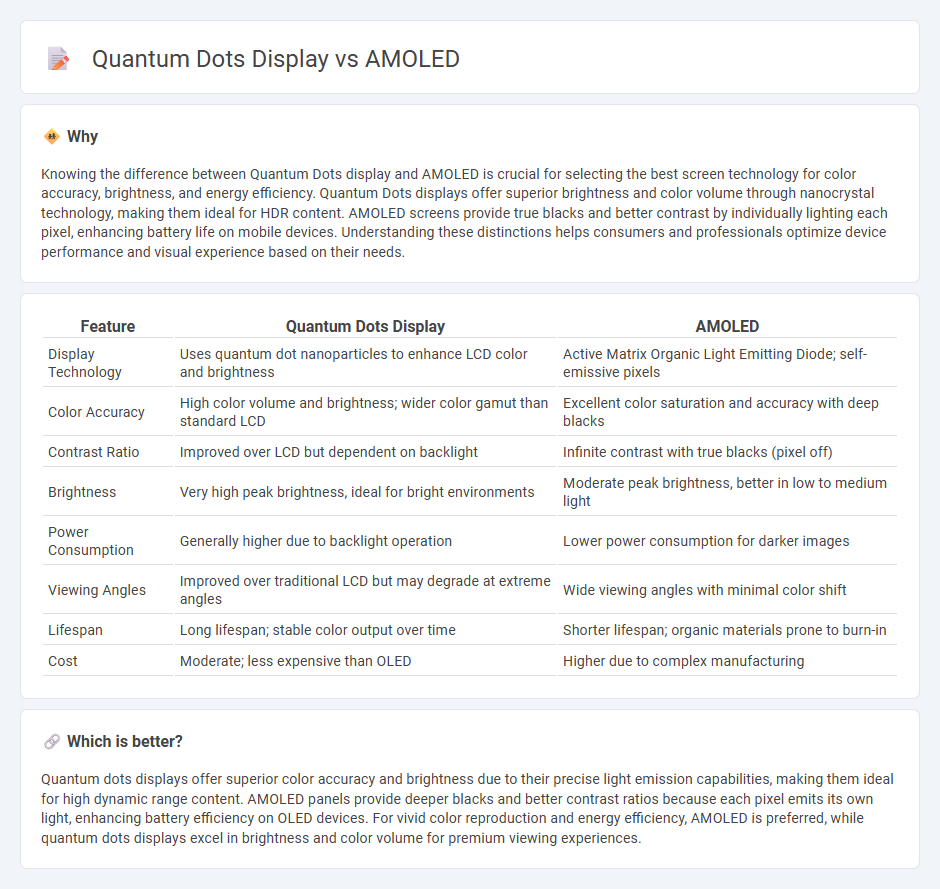
Quantum dots display technology offers superior color accuracy and brightness by utilizing semiconductor nanocrystals to emit precise light frequencies, enhancing visual performance compared to traditional displays. AMOLED displays provide deep blacks and high contrast ratios through self-emissive organic pixels that switch off individually, optimizing power efficiency and image quality. Explore the detailed comparison to understand which display technology best suits your needs.
Why it is important
Knowing the difference between Quantum Dots display and AMOLED is crucial for selecting the best screen technology for color accuracy, brightness, and energy efficiency. Quantum Dots displays offer superior brightness and color volume through nanocrystal technology, making them ideal for HDR content. AMOLED screens provide true blacks and better contrast by individually lighting each pixel, enhancing battery life on mobile devices. Understanding these distinctions helps consumers and professionals optimize device performance and visual experience based on their needs.
Comparison Table
| Feature | Quantum Dots Display | AMOLED |
|---|---|---|
| Display Technology | Uses quantum dot nanoparticles to enhance LCD color and brightness | Active Matrix Organic Light Emitting Diode; self-emissive pixels |
| Color Accuracy | High color volume and brightness; wider color gamut than standard LCD | Excellent color saturation and accuracy with deep blacks |
| Contrast Ratio | Improved over LCD but dependent on backlight | Infinite contrast with true blacks (pixel off) |
| Brightness | Very high peak brightness, ideal for bright environments | Moderate peak brightness, better in low to medium light |
| Power Consumption | Generally higher due to backlight operation | Lower power consumption for darker images |
| Viewing Angles | Improved over traditional LCD but may degrade at extreme angles | Wide viewing angles with minimal color shift |
| Lifespan | Long lifespan; stable color output over time | Shorter lifespan; organic materials prone to burn-in |
| Cost | Moderate; less expensive than OLED | Higher due to complex manufacturing |
Which is better?
Quantum dots displays offer superior color accuracy and brightness due to their precise light emission capabilities, making them ideal for high dynamic range content. AMOLED panels provide deeper blacks and better contrast ratios because each pixel emits its own light, enhancing battery efficiency on OLED devices. For vivid color reproduction and energy efficiency, AMOLED is preferred, while quantum dots displays excel in brightness and color volume for premium viewing experiences.
Connection
Quantum dots displays utilize nanoscale semiconductor particles that emit precise colors when exposed to light, enhancing color accuracy and brightness in screens. AMOLED (Active Matrix Organic Light Emitting Diode) technology relies on organic compounds that emit light when electrically stimulated, offering deep blacks and high contrast ratios. Integrating quantum dots with AMOLED panels improves color gamut and energy efficiency, combining the vibrant light emission of organic diodes with the advanced color tuning of quantum dots for superior display performance.
Key Terms
OLED (Organic Light-Emitting Diode)
OLED (Organic Light-Emitting Diode) displays provide superior contrast ratios and deeper blacks compared to Quantum Dot displays due to their self-emissive pixel technology that eliminates backlighting. AMOLED, a type of OLED, enhances functionality with faster refresh rates and better energy efficiency, making it ideal for smartphones and wearable devices. Explore more to understand how OLED innovations drive advancements in display technology.
Quantum Dots
Quantum dot displays utilize semiconductor nanocrystals that emit precise colors when illuminated, resulting in enhanced color accuracy and brightness compared to traditional AMOLED screens. These displays offer superior energy efficiency and longer lifespan by reducing power consumption and minimizing screen burn-in risks. Explore how quantum dot technology is revolutionizing visual experiences with unmatched clarity and vibrant hues.
Color Gamut
AMOLED displays offer a wide color gamut with vibrant and deep hues due to their organic light-emitting diodes that emit pure colors individually. Quantum dot displays enhance color accuracy and brightness by using semiconductor nanocrystals that emit precise wavelengths when backlit, achieving a broader and more saturated color range than traditional LCDs. Explore more about how these technologies impact visual experience and device performance.
Source and External Links
AMOLED and OLED displays: Understanding the differences - AMOLED stands for active matrix organic light-emitting, a type of OLED featuring an active matrix of thin-film transistors and storage capacitors that control each pixel for smooth motion and excellent refresh rates, while also allowing for flexible displays and power savings when showing dark content--though at the risk of burn-in and higher production costs.
What Exactly is AMOLED? - AMOLED (active-matrix organic light-emitting diode) is an advanced display technology that uses an active matrix for precise pixel control, resulting in fast response times, vibrant colors, wide viewing angles, and ultra-thin, flexible panels that outperform traditional LED and LCDs in devices like smartphones and wearables.
What is a Dynamic AMOLED Screen? - AMOLED screens offer exceptional picture quality with high contrast and expansive color gamut, reduced power consumption by individually lighting pixels, ultra-fast refresh rates for smooth visuals, and ultra-slim, bendable designs--making them ideal for premium smartphones and devices.
 dowidth.com
dowidth.com